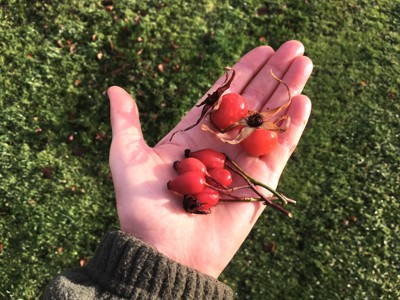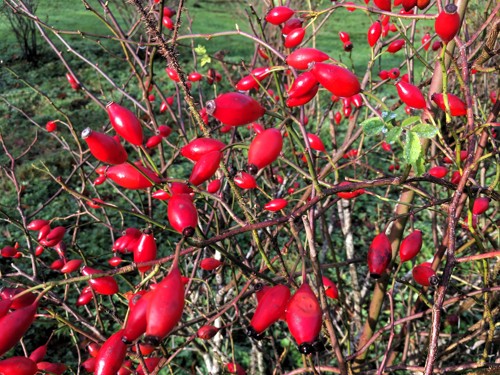
Get hip – wild food foraging in winter
3rd Jan 2024
Wildwood Devon's foraging expert, Bex Flintham, explains how wild food can be found anywhere...even in winter!

Foraging expert, Bex Flintham
Winter may not seem like the best time for finding wild foods… But clinging to thorny branches in our hedgerows and scrublands in early winter are bright red rose hips, the fruits of our wild dog rose (pink-flowered Rosa canina) and field rose (white-flowered Rosa arvensis). Rose hips are enjoyed by so-called ‘winter thrushes’: the colourful Redwing (Turdus iliacus) and noisy Fieldfare (Turdus pilaris), winter visitors from their breeding grounds in Scandinavia, Russia and northern/eastern Europe. Fieldfares and Redwings mass in large flocks, gleaning their way across the countryside feeding on rose hips and berries of holly, hawthorn and yew trees; along with garden shrubs such as Cotoneaster, Berberis and Pyracantha.

Rose hips
You can use garden and wild rose hips to make rose hip syrup. Chop your collected hips (e.g. in a food processor), add enough water to cover them in a large saucepan, bring to the boil and simmer for 15 minutes. When cool, strain through a double layer of muslin to remove the irritant hairs found around the seeds: leave to drip for half an hour, to get all the juice. Take a fresh double layer of muslin and strain the juice a second time. Measure strained juice into a clean saucepan, and for each 500ml add 350g of sugar. Heat and stir until sugar dissolves, then boil for 5 minutes. Remove from heat and pour into warm sterilised glass jars or bottles; or allow to cool and freeze in plastic bottles. Rich in vitamin C, rosehip syrup diluted as a hot drink is a great winter standby for colds and flu – and it tastes great on ice cream or drizzled on porridge, too!

Rose hip syrup
Use your rose hip juice to make lokum (Turkish delight). For every 500ml of rose hip juice add 800g of sugar and 1 tablespoon of lemon juice and bring gently to the boil, stirring constantly. Once boiling, cover and boil for 1 minute; then remove the lid and continue boiling until the temperature of the syrup reaches 115°C. Remove from heat and set aside. In another saucepan add 125g cornflour and 1 teaspoon of cream of tartar and gradually stir in 500ml of water, stirring with a whisk to avoid lumps. Once mixed cook gently over heat, stirring well with a wooden spoon, until the mixture becomes thick and gluey. Remove from heat and stir in rose hip syrup a little at a time with a whisk to ensure it’s well blended. Then return pan to heat and slowly bring to the boil; simmer gently for an hour, stirring with wooden spoon to ensure it doesn’t burn. Remove from heat and pour into a baking tin lined with oiled baking parchment: allow to set for at least 6 hours. Sieve 50g icing sugar and 15g cornflour into a bowl: then sift some of this mixture over the set lokum. Turn the lokum out of its tin onto another sheet of baking parchment and dust with more icing sugar/cornflour: use an oiled knife to cut into cubes, then toss the cubes in the bowl of icing sugar/cornflour until well coated.
As always with foraging, remember to stay safe: some berries and fruits are poisonous, so use plant identification guides or apps to make sure that you are foraging rose hips, and not other (possibly toxic) fruits!
You can learn how to forage by coming to one of our Foraging Wild workshops at Wildwood Devon, running from May to October. Click here for more details: devon.wildwoodtrust.org/tickets-passes/foraging-wild
